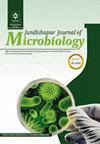Exploring Drug-Resistant Mutations in Protease Inhibitors and Subtype Distribution Among HIV-1 Positive Patients in Lorestan Province, Iran
IF 0.5
4区 医学
Q4 MICROBIOLOGY
引用次数: 0
Abstract
: This study focuses on drug-resistant mutations in protease inhibitors (PIs) and the distribution of Human immunodeficiency virus type 1 (HIV-1) subtypes in Lorestan province, Iran. A total of 59 patients were categorized into two groups: Recipients of antiretroviral therapy (ART) and drug-naive individuals. Genotypic resistance testing was performed using nested PCR, followed by sequencing and analysis of the PCR product to identify drug-resistance mutations and determine the viral subtype. Among the ART recipients, 11 (78%) exhibited major mutations, while 3 (22%) had minor mutations specifically in PIs. The most commonly observed major protease inhibitor (PI) mutations were D30N (27.2%) and V32I (27.2%), followed by G48A (18.1%), L90M (18.1%), and L76V (9%). The most frequent minor PI mutations recorded were K20R (40%), L10I (20%), F53I (20%), and V11I (20%). No drug resistance was detected in drug-naive patients. Lopinavir (LPV) and nelfinavir (NFV) exhibited the highest levels of resistance, while saquinavir (SQV) and fosamprenavir (FPV) showed the highest levels of susceptibility. All participants were found to be infected with CRF35_AD, the dominant HIV-1 subtype in Iran. This study represents the first attempt in the region to analyze drug-resistant mutations in PIs among ART-experienced patients in Lorestan province. The findings contribute to ongoing efforts aimed at controlling the spread of drug-resistant HIV-1 strains.探究伊朗洛雷斯坦省 HIV-1 阳性患者中蛋白酶抑制剂的耐药突变和亚型分布
:这项研究的重点是蛋白酶抑制剂(PIs)的耐药突变以及伊朗洛雷斯坦省 1 型人类免疫缺陷病毒(HIV-1)亚型的分布情况。共有 59 名患者被分为两组:接受抗逆转录病毒疗法(ART)的患者和未接受药物治疗的患者。采用巢式 PCR 进行基因型耐药性检测,然后对 PCR 产物进行测序和分析,以确定耐药性突变并确定病毒亚型。在接受抗逆转录病毒疗法的患者中,有 11 人(78%)出现了主要变异,3 人(22%)出现了专门针对蛋白酶抑制剂的次要变异。最常见的主要蛋白酶抑制剂(PI)突变是 D30N(27.2%)和 V32I(27.2%),其次是 G48A(18.1%)、L90M(18.1%)和 L76V(9%)。最常见的轻微 PI 变异是 K20R(40%)、L10I(20%)、F53I(20%)和 V11I(20%)。未服药患者未发现耐药性。洛匹那韦(LPV)和奈非那韦(NFV)的耐药性水平最高,而沙奎那韦(SQV)和福沙那韦(FPV)的敏感性水平最高。所有参与者都感染了 CRF35_AD,这是伊朗的主要 HIV-1 亚型。这项研究是该地区首次尝试分析洛雷斯坦省有抗逆转录病毒疗法经验的患者对 PIs 的耐药突变。研究结果有助于当前旨在控制耐药 HIV-1 株传播的努力。
本文章由计算机程序翻译,如有差异,请以英文原文为准。
求助全文
约1分钟内获得全文
求助全文
来源期刊

Jundishapur Journal of Microbiology
MICROBIOLOGY-
CiteScore
1.30
自引率
0.00%
发文量
56
审稿时长
6-12 weeks
期刊介绍:
Jundishapur Journal of Microbiology, (JJM) is the official scientific Monthly publication of Ahvaz Jundishapur University of Medical Sciences. JJM is dedicated to the publication of manuscripts on topics concerning all aspects of microbiology. The topics include medical, veterinary and environmental microbiology, molecular investigations and infectious diseases. Aspects of immunology and epidemiology of infectious diseases are also considered.
 求助内容:
求助内容: 应助结果提醒方式:
应助结果提醒方式:


